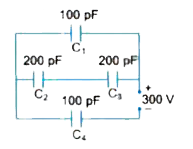ADDITIONAL EXERCISES from U-LIKE PHYSICS (HINGLISH) ELECTROSTATIC POTENTIAL AND CAPACITANCE for Class 12
| Class 12 | PHYSICS |
| Chapter | ELECTROSTATIC POTENTIAL AND CAPACITANCE |
| U-LIKE PHYSICS (HINGLISH) | ADDITIONAL EXERCISES |
| Medium | English |
| Academic Year | 2023-2024 |
Question 3
Two tiny spheres carrying charges 1.5μCand2.5μC are located 30 cm apart. Find the potential and electric field:
(a) at the mid-point of the line joining the two charges, and
(b) at a point 10 cm from this mid-point in a plane normal to the line and passing through the mid point. View SolutionQuestion 6
Show that the normal component of electrostatic field has a discontinuity from one side of a charged surface to another given by
(→E2−→E1).Htan=σε0
where ˆn is a unit vector normal to the surface at a point and o is the surface charge density at that point. (The direction of în is from side 1 to side 2). Hence, show that just outside a conductor, the electric field is σε0ˆn.View SolutionQuestion 9
In a hydrogen atom, the electron and proton are bound at a distance of about 0.53 Å :
(a) Estimate the potential energy of the system in eV, taking the zero of the potential energy at infinite separation of the electron from proton.
(b) What is the minimum work required to free the electron, given that its kinetic energy in the orbit is half the magnitude of potential energy obtained in (a)?
(c) What are the answers to (a) and (b) above if the zero of potential energy is taken at 1.06 Å separation ?View SolutionQuestion 10
If one of the two electrons of a H2 molecule is removed, we get a hydrogen molecular ion H+2.In the ground state of an H+2, the two protons are separated by roughly 1.5 Å, and the electron is roughly 1 Å from each proton. Determine the potential energy of the system. Specify your choice of the zero of potential energy.View SolutionQuestion 11
Two charged conducting spheres of radii a and b are connected to each other by a wire. What is the ratio of electric fields at the surfaces of the two spheres ? Use the result obtained to explain why charge density on the sharp and pointed ends of a conductor is higher than on its flatter portions. View SolutionQuestion 14
Two charges - q and +q are located at points (0, 0, - a) and (0,0, a), respectively.
How much work is done in moving a small test charge from the point (5, 0, 0) to (-7,0,0) along the x-axis ? Does the answer change if the path of the test charge between the same points is not along the x-axis ? View SolutionQuestion 16
An electrical technician requires a capacitance of 2 uF in a circuit across a potential difference of 1 kV. A large number of 1 uF capacitors are available to him each of which can withstand a potential difference of not more than 400 V. Suggest a possible arrangement that requires the minimum number of capacitors.View SolutionQuestion 17
What is the area of the plates of a 2 F parallel plate capacitor, given that the separation between the plates is 0.5 cm ? [You will realise from your answer why ordinary capacitors are in the range of uF or less. However, electrolytic capacitors do have a much larger capacitance (0.1 F) because of very minute seperation between the conductors.] View SolutionQuestion 20
The plates of a parallel plate capacitor have an area of 90cm2? each and are separated by 2.5 mm. The capacitor is charged by connecting it to a 400 V supply.
View this energy as stored in the electrostatic field between the plates and obtain the energy per unit volume u. Hence arrive at a relation between u and the magnitude of electric field E between the plates. View SolutionQuestion 30
A parallel plate capacitor is to be designed with a voltage rating 1 kV, using a material of dielectric constant 3 and dielectric strength about 107Vm−1. (Dielectric strength is the maximum electric field a material can tolerate without breakdown, i.e., without starting to conduct electricity through partial ionisation). For safety, we should like the field never to exceed, say 10% of the dielectric strength. What minimum area of the plates is required to have a capacitance of 50 pF ?View SolutionQuestion 31
Describe schematically the equipotential surfaces corresponding to
(a) a constant electric field in the z-direction,
(b) a field that uniformly increases in magnitude but remains in a constant (say, z) direction,
(c) a single positive charge at the origin, and
(d) a uniform grid consisting of long equally spaced parallel charged wires in a plane. View SolutionQuestion 33
The top of the atmosphere is at about 400 kV with respect to the surface of the earth, corresponding to an electric field that decreases with altitude. Near the surface of the earth, the field is about 100 Vm−7. Why then do we not get an electric shock as we step out of our house into the open ? (Assume the house to be a steel cage so there is no field inside)View SolutionQuestion 35
The discharging current in the atmosphere due to the small conductivity of air is known to be 1800 A on an average over the globe. Why then does the atmosphere not discharge itself completely in due course and become electrically neutral ? In other words, what keeps the atmosphere charged ?View Solution

